Ask yourself this question: If my company was thinking about adopting a Human Performance process to reduce the frequency and severity of human error, who would be the internal owner? In other words, what person, group, or department would oversee the implementation and development of the Human Performance program?
 Most of you probably said “Safety.” This is a common and understandable response. Being in an industrial setting, our natural reaction is to equate errors with accidents. This is a natural bias (if you’re a glutton for punishment you can look back at our series on cognitive biases here).
Most of you probably said “Safety.” This is a common and understandable response. Being in an industrial setting, our natural reaction is to equate errors with accidents. This is a natural bias (if you’re a glutton for punishment you can look back at our series on cognitive biases here).
We develop this “error = accident” bias because we never really look at the impact of human error unless we are forced. If someone gets hurt, we are certainly going to look deeply at the root cause and corrective actions; we have no choice.
If the result of an error can be characterized as “no harm-no foul” then we probably have the choice to only give it some superficial thought. If the Human Error just caused some rework, inefficiency, lost productivity, or scrapped material it could just be chalked up to the “cost of doing business.” The cost is usually something smaller that can be absorbed by a little schedule or budget “margin of error.” You aren’t really forced to confront it because, after all, OSHA couldn’t care less if you are efficient; they just want you safe.
Every once in a while, there will be a human error so massive that it can’t be dismissed as an unfortunate part of the process. Have you heard about the Spanish S-80 “Plus” submarine that first wouldn’t float and now won’t fit in its dock? (You can find an article about it here.)
It was discovered in 2013 that the first of the S-80 submarines couldn’t go out to sea because it was 70 tons too heavy and designers feared it will not be able to resurface. What could possibly make a submarine 70 tons too heavy? It was one person, early in the design process, putting a decimal point in the wrong place and no one catching the human error until it was too late.
That’s OK. For the low, low price of $14 million, U.S. defense contractor Electric Boat consulted on the problem and gave the Spanish Navy a few ideas on how to account for the extra weight.
As it turns out, if you increase the length of the boat by about 30 feet, it will increase its buoyancy (way oversimplified here, but think more internal space for lifty-air). This would be enough to overcome the extra 70 tons of weight.
The S-80 then became the S-80 Plus. You would assume that the “Plus” is referring to the extra length, but it could just as easily refer to the extra cost. The $14 million was just for weighing (no pun intended) their options. Actually lengthening the boat doubled its cost to almost $1 billion each.
Problem solved. Except not really. Now the S-80 Plus is too long to fit in its dock. The Naval Base at Cartagena will have to dredge and reshape its docks to accommodate the now longer boat. No word on expected costs for that.
Keep this in mind: No one got hurt. The were no OSHA recordables. There were no hits to their TRIR or DART. But—wow!—there was a cost as the S-80 was years late, way over budget, and still having problems, all from a decimal in the wrong spot.
Yes, this is an extreme example and we seldom see errors of this magnitude. However, if we added up all the “little” errors that are just brushed aside throughout the year as the “cost of doing business,” I bet the number would shock us.
Human Performance is not just a “safety thing.” It’s about not making errors. Errors impact a wide array of things, from accuracy, efficiency, and productivity to—yes—safety. Increased safety is a byproduct of a human performance culture; an important one that is easiest to see but still a byproduct of being error-free. Safety doesn’t own Human Performance; everyone does. Ownership should be higher in the organization than the safety department. Otherwise you’re missing the boat (pun intended).
Toolbox Talks offers quick insights and thoughts to use for your toolbox (tailboard) talks. Dave Sowers is a founding member of Knowledge Vine, a veteran-owned human performance training and consulting organization that strives to reduce the frequency and severity of human errors in the workplace. He has almost 30 years of experience in power generation and the utility industry. He is a veteran of U.S. Navy Nuclear Power Program and holds a bachelor’s degree in resources management and a master’s degree in both management and emergency management and homeland security.



